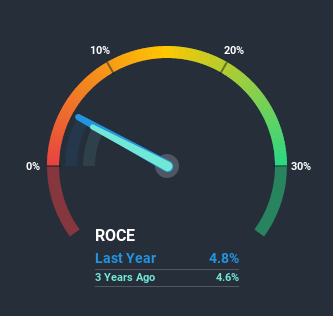
If you're looking at a mature business that's past the growth phase, what are some of the underlying trends that pop up? Typically, we'll see the trend of both return on capital employed (ROCE) declining and this usually coincides with a decreasing amount of capital employed. Trends like this ultimately mean the business is reducing its investments and also earning less on what it has invested. Having said that, after a brief look, Sanrin (TYO:7486) we aren't filled with optimism, but let's investigate further.
What is Return On Capital Employed (ROCE)?
If you haven't worked with ROCE before, it measures the 'return' (pre-tax profit) a company generates from capital employed in its business. Analysts use this formula to calculate it for Sanrin:
Return on Capital Employed = Earnings Before Interest and Tax (EBIT) ÷ (Total Assets - Current Liabilities)
0.048 = JP¥938m ÷ (JP¥25b - JP¥5.2b) (Based on the trailing twelve months to September 2020).
So, Sanrin has an ROCE of 4.8%. On its own that's a low return on capital but it's in line with the industry's average returns of 5.0%.
See our latest analysis for Sanrin

Historical performance is a great place to start when researching a stock so above you can see the gauge for Sanrin's ROCE against it's prior returns. If you'd like to look at how Sanrin has performed in the past in other metrics, you can view this free graph of past earnings, revenue and cash flow.
How Are Returns Trending?
We are a bit worried about the trend of returns on capital at Sanrin. About five years ago, returns on capital were 6.3%, however they're now substantially lower than that as we saw above. On top of that, it's worth noting that the amount of capital employed within the business has remained relatively steady. Companies that exhibit these attributes tend to not be shrinking, but they can be mature and facing pressure on their margins from competition. If these trends continue, we wouldn't expect Sanrin to turn into a multi-bagger.
In Conclusion...
In summary, it's unfortunate that Sanrin is generating lower returns from the same amount of capital. In spite of that, the stock has delivered a 39% return to shareholders who held over the last five years. Either way, we aren't huge fans of the current trends and so with that we think you might find better investments elsewhere.
If you'd like to know about the risks facing Sanrin, we've discovered 1 warning sign that you should be aware of.
While Sanrin isn't earning the highest return, check out this free list of companies that are earning high returns on equity with solid balance sheets.
If you decide to trade Sanrin, use the lowest-cost* platform that is rated #1 Overall by Barron’s, Interactive Brokers. Trade stocks, options, futures, forex, bonds and funds on 135 markets, all from a single integrated account. Promoted
New: Manage All Your Stock Portfolios in One Place
We've created the ultimate portfolio companion for stock investors, and it's free.
• Connect an unlimited number of Portfolios and see your total in one currency
• Be alerted to new Warning Signs or Risks via email or mobile
• Track the Fair Value of your stocks
This article by Simply Wall St is general in nature. It does not constitute a recommendation to buy or sell any stock, and does not take account of your objectives, or your financial situation. We aim to bring you long-term focused analysis driven by fundamental data. Note that our analysis may not factor in the latest price-sensitive company announcements or qualitative material. Simply Wall St has no position in any stocks mentioned.
*Interactive Brokers Rated Lowest Cost Broker by StockBrokers.com Annual Online Review 2020
Have feedback on this article? Concerned about the content? Get in touch with us directly. Alternatively, email editorial-team (at) simplywallst.com.
About TSE:7486
Sanrin
Manufactures and sells briquette, bean coal, petroleum, LP gas, and other fuel products in Japan.
Flawless balance sheet average dividend payer.
Market Insights
Community Narratives




